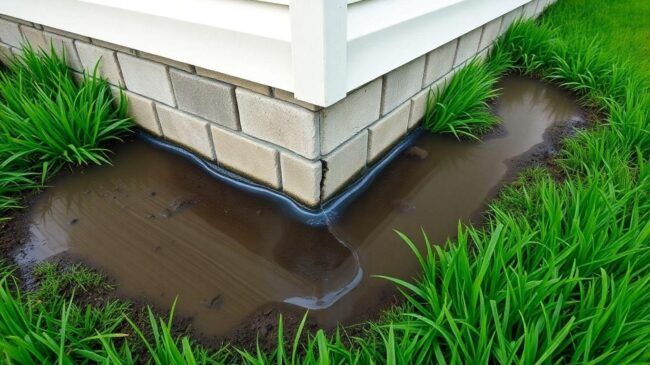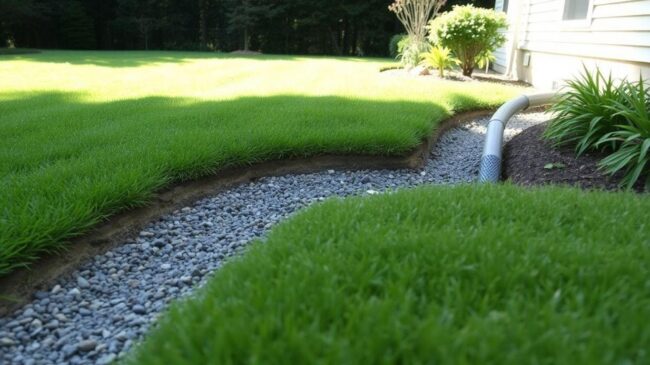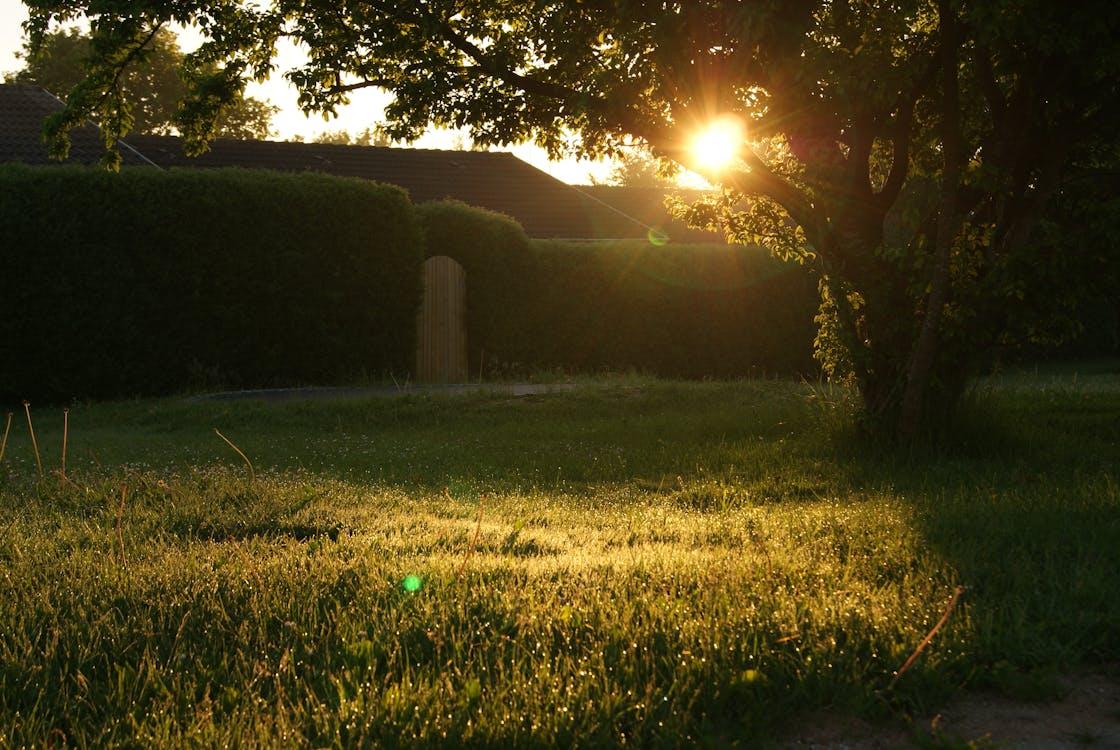Preventing Foundation Damage
Water is a sneaky enemy. When it sits around your home’s foundation, it pushes against the concrete. This constant pressure, called hydrostatic pressure, can create tiny cracks. Over time, these cracks get bigger. Water gets in, freezes, expands, and makes the cracks even worse. This can lead to serious structural problems that cost a fortune to fix. Proper yard drainage is your first line of defense against this. It directs water away, keeping that pressure off your foundation. Think of it as giving your home a dry, stable base to sit on.
Protecting Your Basement and Crawl Space
Basements and crawl spaces are often the lowest points on a property, making them prime targets for water intrusion. If your yard doesn’t drain well, rain and melting snow can find their way into these areas. This leads to dampness, which is a perfect breeding ground for mold and mildew. Mold isn’t just unsightly; it can cause health problems and damage your belongings. Plus, a wet basement is an invitation for pests. Good yard drainage stops water before it even gets close to these vulnerable parts of your house.
Avoiding Soil Erosion and Landscape Deterioration
When water doesn’t drain properly, it starts to move soil around. This is called erosion. On slopes, water can wash away the topsoil, leaving plants struggling to get nutrients and making the ground unstable. Even on flat areas, constant sogginess can kill grass and damage plant roots. This not only makes your yard look bad but can also lead to bigger problems, like sinkholes or damage to walkways and patios. Effective drainage keeps your soil in place and your landscape healthy and attractive.
Identifying Signs of Drainage Problems

Sometimes, you don’t realize you have a drainage issue until water starts causing trouble. Paying attention to your yard and home can help you spot problems early. These signs are your first clue that something needs attention before it becomes a bigger, more expensive headache. Catching these issues early is key to preventing serious damage.
Recognizing Water Pooling and Soggy Soil
Does water sit around your house or in certain spots in the yard long after it rains? That’s a big sign of poor yard drainage. You might see puddles that just won’t disappear, or areas where the ground stays wet and mushy for days. This constant dampness can make your lawn look unhealthy, with grass turning yellow or plants struggling to grow. Soggy soil also means roots can’t get enough air, which is bad for your plants and can lead to them dying off. It’s a clear indicator that water isn’t moving away like it should.
Spotting Erosion and Landscape Issues
Look closely at any slopes or garden beds. If you see soil washing away, especially after heavy rain, that’s erosion. It means water is running off too fast and taking the topsoil with it. This can leave plant roots exposed and create bare patches in your yard. Over time, this erosion can make your landscape look messy and uneven. It also weakens the soil structure, making it harder for plants to stay put and thrive. Erosion is a visual cue that your yard drainage isn’t working properly.
Detecting Basement Leaks and Mold Growth
Inside your home, watch for damp spots on walls or floors, especially in the basement or crawl space. Musty smells are another warning sign. These often point to water seeping in, which is a direct result of poor yard drainage outside. If you start seeing mold or mildew, it’s a serious indicator that moisture has been present for a while. This isn’t just unsightly; it can affect your home’s air quality and lead to health problems. Addressing the external drainage issues is the first step to stopping these internal problems.
Common Causes of Yard Drainage Issues
Several factors can lead to water pooling and saturation in your yard, creating potential problems for your home’s structure and landscape. Understanding these common causes is the first step toward preventing costly water damage.
The Impact of Poor Grading
Poor grading is a frequent culprit behind yard drainage problems. Grading refers to the slope of the land around your house. If the ground doesn’t slope away from your foundation, water will naturally flow towards it, collecting in low spots. This can lead to soggy soil and, over time, serious issues like basement flooding. A proper slope directs water safely away from your home’s structure. Without adequate grading, even a mild rain can become a significant water problem.
Understanding Compacted Soil
Compacted soil makes it difficult for water to soak into the ground. When soil particles are pressed together tightly, often due to heavy foot traffic, construction, or even just clay-rich soil, water tends to run off the surface instead of being absorbed. This surface runoff can then pool in areas, contributing to erosion and landscape deterioration. Addressing compacted soil is key to improving overall yard drainage.
Issues with Gutters and Hardscaping
Your home’s gutters and downspouts are designed to move water away from the foundation. However, clogged gutters or improperly directed downspouts can dump large amounts of water right where you don’t want it. Similarly, hardscaping elements like patios and driveways, if not installed with proper drainage in mind, can create impermeable surfaces that prevent water absorption and direct runoff towards your home. These hardscaping issues, combined with gutter problems, significantly impact how water moves across your property.
Ignoring these common causes of poor yard drainage can lead to a cascade of problems, from minor landscape annoyances to major structural damage. Proactive assessment and solutions are always better than reactive repairs.
Effective Yard Drainage Solutions

When water starts to become a problem in the yard, it’s time to look at some real solutions. Ignoring it just leads to bigger headaches down the road, like foundation trouble or a soggy lawn that never dries out. Luckily, there are several ways to get that water moving away from your home.
The Benefits of French Drains
A French drain is a super common and effective way to handle water that likes to hang out where it shouldn’t. Basically, it’s a trench dug in the ground, usually filled with gravel, and it has a pipe inside. This pipe is perforated, meaning it has holes, so water can seep in. The whole setup is designed to collect excess water and send it somewhere else, like a lower part of the yard or a drainage ditch. This system is great for redirecting water away from your foundation and preventing those annoying soggy spots. It’s a solid choice for managing water runoff and keeping your yard from becoming a swamp.
Utilizing Grading and Swales
Sometimes, the simplest solutions are the best. Grading is all about the slope of your yard. If your yard slopes towards your house, that’s a problem waiting to happen. Proper grading means shaping the land so that water naturally flows away from your home’s foundation. It’s like giving water a clear path to follow. Swales are shallow, wide ditches that also help guide water. They often look like gentle depressions in the landscape, maybe with some grass or plants. They work with the grading to channel water safely away. These methods are key for preventing water from pooling.
Implementing Catch Basins and Downspout Extensions
Catch basins are like little collection points for water. They’re typically installed in low spots where water tends to gather, like driveways or patios. Water flows into the basin, and then it’s directed underground through pipes. Think of them as mini-reservoirs that prevent puddles. Downspout extensions are also really important. Your gutters collect rain from your roof, but if the downspouts just dump that water right next to your house, it can cause big problems. Extending the downspouts so they release water much further away from the foundation is a simple but vital step in proper yard drainage. These solutions work together to keep water from causing damage.
When to Seek Professional Drainage Services
Addressing Persistent Flooding and Erosion
If you notice water consistently pooling in certain areas of your yard, especially after rain, it’s a clear sign that your current drainage system isn’t cutting it. This persistent flooding can saturate the soil, weakening its structure and leading to significant landscape issues. Similarly, if you’re seeing noticeable soil erosion, particularly on slopes or near your home’s foundation, it’s time to call in the pros. These aren’t minor inconveniences; they’re indicators of deeper problems that simple fixes can’t resolve. Professionals have the tools and knowledge to assess the root cause and implement effective solutions, like advanced grading or specialized drainage systems, to stop the water damage before it gets worse.
Consulting Experts for Basement and Foundation Leaks
Water seeping into your basement or crawl space is a serious red flag. It often points directly to a yard drainage problem that’s directing water towards your home’s foundation. Ignoring these leaks can lead to costly structural damage, mold growth, and unhealthy indoor air quality. When water starts compromising your home’s integrity, it’s not a DIY situation. Experts can pinpoint exactly where the water is coming from and how it’s getting in. They can then design and install a drainage strategy that redirects water safely away from your foundation, protecting your home’s structure and your family’s health. This is where professional drainage services truly shine.
The Value of Professional French Drain Guys Drainage Services
Sometimes, the problem requires more than just a quick fix. Installing a proper French drain system, for instance, involves understanding soil types, proper trench depth, and the correct materials to ensure it functions effectively for years to come. Professionals bring a level of precision and experience that’s hard to replicate. They look at your property holistically, considering everything from your roof’s runoff to the soil composition. They also have access to specialized equipment that makes the job more efficient and less disruptive to your yard. Homeowners looking for expert solutions can turn to French Drain Guys drainage services, a team known for providing tailored drainage systems that effectively prevent water damage and improve outdoor water flow. Hiring professionals means getting a comprehensive solution, often including coordination with other services like landscaping or hardscaping, to ensure the drainage system is both functional and aesthetically pleasing. It’s an investment that prevents much larger, more expensive repairs down the line.
Investing in Prevention Saves Money
The Cost of Water Damage Repairs
Water damage to a home can get expensive, fast. Think about foundation repairs, which can easily run into the thousands, or dealing with a flooded basement. Mold remediation is another big one, and it’s not just about the cost; it’s about health too. Plus, water can damage electrical systems and even attract pests. Insurance might help, but claims can raise your premiums. It’s a lot cheaper to fix drainage issues now than to deal with the fallout later.
How Drainage Services Prevent Expensive Fixes
Getting professional help for your yard drainage is a smart move. They know how to grade properly, install French drains, or set up catch basins to move water away from your house. This kind of preventative work stops problems before they start. For example, a well-placed downspout extension might seem small, but it can save your foundation from serious damage. Investing in these services is usually a fraction of what you’d pay for major repairs down the road. It’s about protecting your biggest asset.
Long-Term Savings with Proper Drainage
Think of proper yard drainage as a long-term investment. It protects your home’s structure, keeps your landscaping looking good, and prevents those surprise repair bills. A good drainage system can add to your property’s value too. When it’s time to sell, a home with no water issues is much more attractive. So, while there’s an upfront cost, the savings from avoiding major damage and maintaining your home’s integrity add up significantly over the years. It’s a wise choice for any homeowner.
Don’t Let Water Ruin Your Home
So, we’ve talked about how water can really mess things up around your house if it doesn’t drain properly. We’re talking about cracked foundations, soggy basements, and even mold. It might seem like a small thing, but getting your yard’s drainage sorted out is a big deal for keeping your home safe and sound. Taking steps now, whether it’s fixing your gutters or thinking about a French drain, can save you a ton of headaches and money later on. It’s really about protecting your biggest investment. Don’t wait for a flood to realize you should have paid more attention to where all that rain was going.

